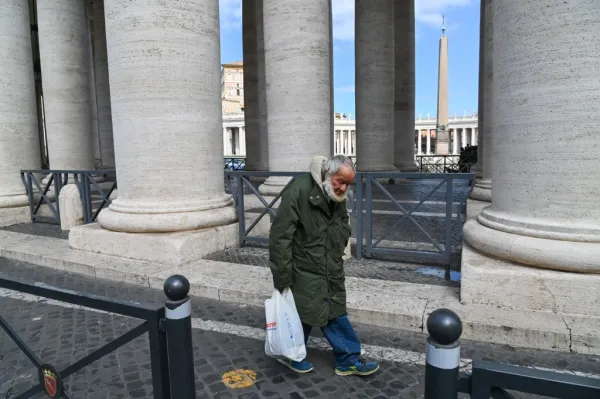
Rome, Italy, Mar 28, 2020 / 02:01 pm (CNA).- Along the edge of Bernini’s colonnade, the semi-circular rows of columns which wrap St. Peter’s Square in Rome, many homeless spend time during the day and sleep at night, as tourists and locals walk by.
But during the coronavirus pandemic, which has led Italian authorities to lock down the country, close St. Peter’s Square, and order everyone to stay home, where can those with nowhere to go find shelter?
There are an estimated 8,000 homeless in Rome, according to Massimiliano Signifredi, communications director for Sant’Egidio, a Catholic community and volunteer network based in Rome.
“Unfortunately, no one has thought of these people,” he told CNA. “These people are at risk, not only because of the virus, but because of isolation.”
Of those 8,000 homeless, he explained that around 3,000 will not be able to find room in shelters across the city, and instead choose “to live at the train stations and at places like St. Peter’s Square, which continues to be a place of refuge for those without a home.”
During the coronavirus pandemic, with the streets abandoned and bars and restaurants closed, “those who do not have a home find themselves in great difficulty,” Signifredi said. “Even to go to the bathroom is a problem without a house; and to wash your hands frequently, like we should, you cannot do if you are on the street.”
One state police officer who works near the Vatican, and who spoke to CNA on condition of anonymity, said one of the places where many homeless typically sleep at night – under the gallery of one of the nearby buildings – is now empty.
But the outer edge of Bernini’s colonnade still hosts many of its usual guests, though numbers are slightly reduced. “Some people really do not want to go; they prefer to stay outside,” the officer said, adding that the police cannot force anyone to go to a shelter against his or her wish.
Despite added risks, the services for homeless men and women near the Vatican have continued uninterrupted, including the papal charities-run showers and bathrooms, located under and between the right colonnade and a Vatican wall.
Now, volunteers take names in the morning of people wanting to use the facilities, and police use the lists to allow those people to enter the area, accessible only through the closed square.
Sant’Egidio and another Catholic charity, Caritas Roma, continuing to distribute food to people in need according to their usual schedules.
Access to a meal is especially difficult during the coronavirus lockdown, since there are no open restaurants giving out food at the end of the day and no one passing by to offer something or to give some money, Signifredi said.
“For these people, we have not interrupted our delivery of food on the street, because we look for these people all year,” he explained. “We know where they are.”
Last November, the Vatican’s office of papal charities and Sant’Egidio together opened a new shelter and soup kitchen in a building facing the colonnade of St. Peter’s Square.
Palazzo Migliori has around 30 beds. Signifredi said previously people would enter the shelter at 7 pm, have dinner, sleep, and leave around 8:00 the next morning. Now, trying to help people stay off the streets even during the day, they have drastically extended these hours.
“So people stay inside their ‘home’ as much as possible,” he said.
Now the guests can enter the shelter at 4:30 pm, staying until the next day after lunch, only having to spend a few hours outside. They can also get all three meals at the soup kitchen.
The Missionaries of Charity also have a center for homeless on Vatican property. One sister told CNA the community in Rome continues “to work and pray” during the coronavirus emergency.
“We continue doing what we are doing, according to the rules and regulations,” she said.
Signifredi said the principle worry of men and women living on the streets right now is “they will not find the necessary help to live, they will be more isolated.”
“They see that the [city’s streets are] empty and that there is no one to help. I can tell you that people are very grateful when we go to find them.”
He said though volunteers are wearing masks and gloves and maintaining one meter of distance between themselves and others, “a physical distance does not mean a human distance.”
“We should continue to communicate the fact that they are our friends… We cannot shake hands or give a hug, but we can continue to communicate our affection for a person.” Even with the mask on the eyes can show a smile, he stated.
The Sant’Egidio community is also sustained by prayer, Signifredi said, and is praying together every day through the internet. “Our online prayer helps us to resist in a moment of great difficulty, in which we lose our reference points, in which we suffer because we cannot pray together, because we cannot celebrate the Eucharist together.”
Prayer, he added, helps you “to not think that these are bad times and you can do nothing, but that really there is a horizon of hope.”
If you value the news and views Catholic World Report provides, please consider donating to support our efforts. Your contribution will help us continue to make CWR available to all readers worldwide for free, without a subscription. Thank you for your generosity!
Click here for more information on donating to CWR. Click here to sign up for our newsletter.



The Sant’Egidio community is serving humanity with dedication. May those gallant community members be blessed with strength and stamina.